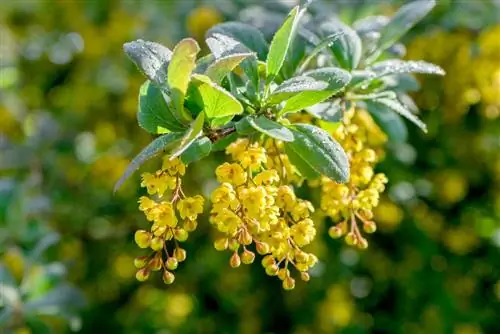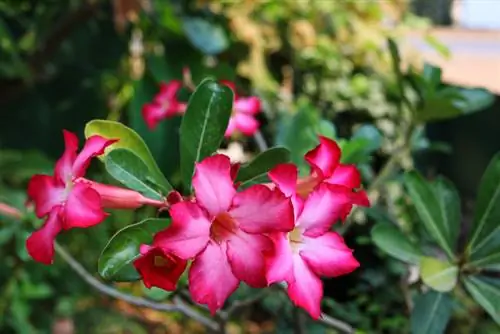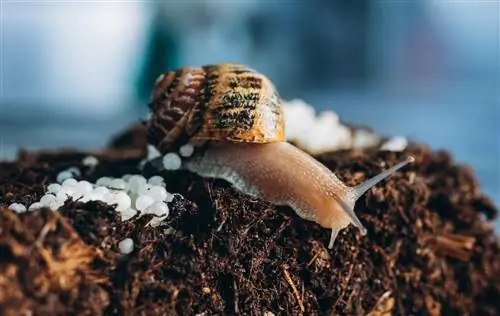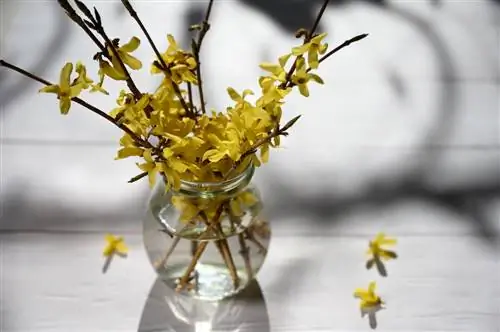- Author admin [email protected].
- Public 2023-12-16 16:46.
- Last modified 2025-01-23 11:22.
The forsythia, also known as the golden bell because of the characteristic color of its flowers, can be found in many gardens. The early bloomer boasts a multitude of golden-yellow bell-shaped flowers, but produces neither nectar nor pollen. Therefore, insect-friendly shrubs should be planted in the garden instead.
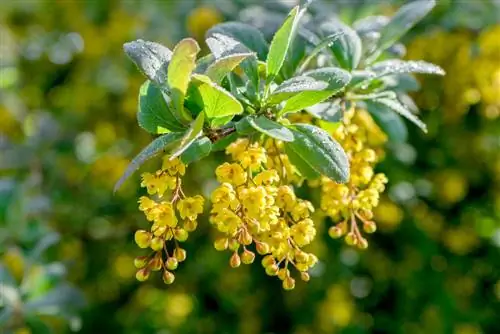
What alternatives are there for forsythia?
As alternatives to forsythia, native wild trees such as copper rock pear, single hawthorn, blackthorn, viburnum, wild apple and wild blackberry are recommended. Yellow-flowering, early-flowering shrubs such as cornelian cherry, barberry, golden currant, mahonia and bell hazel are also good options.
Why don't bees go to forsythia?
Forsythia originally comes from southeastern Europe, although hybrid varieties are mainly found in German gardens ('Lynwood' is particularly popular). These usually haveneither pollen nor nectar and are therefore generally avoided by insects. According to reports, only the privet moth (Sphinx ligustri) has adopted the forsythia as a food plant for its larvae.
Which plant is a good alternative to forsythia?
Good alternatives to sterile forsythia are allnative wild trees, for example
- Copper rock pear (Amelanchier lamarckii): white flowers in April, edible fruits
- Single-handled hawthorn (Crataegus monogyna): strongly fragrant, white flowers from May to June
- Blackthorn / Blackthorn (Prunus spinosa): white flowers from April to May, usable fruits
- Common viburnum (Viburnum opulus): creamy white disc flowers from May to June
- Wild apple (Malus sylvestris): white flowers from April to May, edible fruits
- Wild blackberry (Rubus fruticosus): white cup flowers from June to August, edible fruits
This list is of course not complete, but only presents an excerpt of possible species.
Which yellow-flowered shrubs bloom at the same time as forsythia?
If you are looking for a yellow-flowering, early-flowering alternative to forsythia instead, we can recommend these species:
- Cornelian cherry (Cornus mas): blooms before the leaves emerge March to April, edible fruits
- Barberry / sour thorn (Berberis vulgaris): small cup flowers May to June, well suited for hedges
- Golden currant (Ribes aureum): cluster flowers between April and May
- Mahonia (Mahonia aquifolium): flowering period April to May
- Bell hazel (Corylopsis pauciflora): fragrant flowers between March and April
The Sal willow (Salix caprea) with its early-appearing, nectar- and pollen-rich catkins as well as numerous early-blooming flowers also provide plenty of food for wild bees and their relatives, such as the bumblebee.
What is a forsythia?
Forsythia aresmall shrubsthat can grow up to three meters high and are very flowery. However, these are so-calledpseudoflowers, which have no ecological value. However, the trees not only score points with their joy of flowering, but also with properties that are important for the hobby gardener such as
- Cutting tolerance
- Robustness
- He alth
- Adaptability
The shrub is also very easy to care for. Forsythia can be planted individually or in groups. As soon as they have developed their foliage after flowering, they form a good privacy screen in the garden. The popular garden shrubs belong to the olive tree family.
Tip
Different species
There are different types of forsythia, although the sterile hybrid form Forsythia x intermedia and its varieties can be found in gardens. The equally popular snow forsythia (Abeliophyllum distichum) with its numerous, almond-scented flowers between March and April is also known as “white forsythia”, but is not related to the yellow-flowering species.

